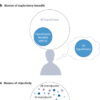An improved charging protocol might help lithium-ion batteries to last much longer. Charging with a high-frequency pulsed current reduces aging effects, an international team demonstrated. The study was led by Philipp Adelhelm (HZB and Humboldt University) in collaboration with teams from the Technical University of Berlin and Aalborg University in Denmark. Experiments at the X-ray source BESSY II were particularly revealing.
Lithium-ion batteries are powerful, and they are used everywhere, from electric vehicles to electronic devices. However, their capacity gradually decreases over the course of hundreds of charging cycles. The best commercial lithium-ion batteries with electrodes made of so-called NMC532 (molecular formula: LiNi0.5Mn0.3Co0.2O2) and graphite have a service life of up to eight years. Batteries are usually charged with a constant current flow.
But is this really the most favorable method? A new study by Prof. Philipp Adelhelm’s group at HZB and Humboldt-University Berlin answers this question clearly with “no.” The study is published in the journal Advanced Energy Materials and analyzes the effect of the charging protocol on the service time of the battery.
Aging effects analyzed
Part of the battery tests were carried out at Aalborg University. The batteries were either charged conventionally with constant current (CC) or with a new charging protocol with pulsed current (PC). Post-mortem analyses revealed clear differences after several charging cycles: In the CC samples, the solid electrolyte interface (SEI) at the anode was significantly thicker, which impaired the capacity.
The team also found more cracks in the structure of the NMC532 and graphite electrodes, which also contributed to the loss of capacity. In contrast, PC-charging led to a thinner SEI interface and fewer structural changes in the electrode materials.
Synchrotron experiments at BESSY II and PETRA III
HZB researcher Dr. Yaolin Xu then led the investigation into the lithium-ion cells at Humboldt University and BESSY II with operando Raman spectroscopy and dilatometry as well as X-ray absorption spectroscopy to analyze what happens during charging with different protocols. Supplementary experiments were carried out at the PETRA III synchrotron.
“The pulsed current charging promotes the homogeneous distribution of the lithium ions in the graphite and thus reduces the mechanical stress and cracking of the graphite particles. This improves the structural stability of the graphite anode,” he concludes. The pulsed charging also suppresses the structural changes of NMC532 cathode materials with less Ni-O bond length variation.
The pulse current frequency is crucial
However, the frequency of the pulsed current counts: High-frequency PC charging protocols with square-wave current extend the service life of commercial LIBs the most, with a doubled cycle life (with 80% capacity retention) achieved in this study.
Co-author Prof. Dr. Julia Kowal, an expert in electrical energy storage technology at TU Berlin, emphasizes, “Pulsed charging could bring many advantages in terms of the stability of the electrode materials and the interfaces and significantly extend the service life of batteries.”
More information:
Jia Guo et al, Unravelling the Mechanism of Pulse Current Charging for Enhancing the Stability of Commercial LiNi0.5Mn0.3Co0.2O2/Graphite Lithium‐Ion Batteries, Advanced Energy Materials (2024). DOI: 10.1002/aenm.202400190
Provided by
Helmholtz Association of German Research Centres
Citation:
BESSY II: How pulsed charging enhances the service time of batteries (2024, April 9)



